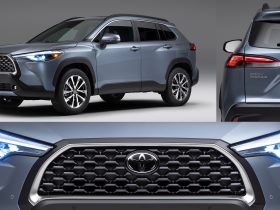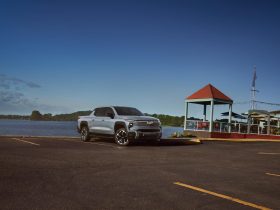What began as an initial deployment of next-generation cellular vehicle-to-everything (C-V2X) technologies has now yielded a wealth of insights to safety benefits in the real world for drivers, passengers, and vulnerable roadside workers. Together, Audi of America, American Tower, Commsignia, Qualcomm Technologies, Inc., Traffic Technology Services, the Virginia Department of Transportation, and Virginia Tech Transportation Institute (VTTI) were able to develop intuitive communications tools to alert drivers when they are entering work zones, including shifting traffic patterns, visibly and audibly notifying roadside workers when vehicles are close to a work zone, and building on Audi’s existing Traffic Light Information with new red light violation warnings.
Stakeholders gained insights how to develop this pivotal technology and make it commercially viable and scalable for automakers, government agencies, and infrastructure providers as it nears production.
Audi anticipates C-V2X will help vehicles communicate with traffic signals and road signs, opening a world of truly automated vehicles that augment their cameras and sensors with cellular frequencies as well and no longer relying solely on visible vehicles and road markings to help drivers move safely down the road. The development of C-V2X accelerates these potential applications.
Now is the time
The ability to realize the potential safety benefits of C-V2X technology became possible following a U.S. Federal Communications Commission (FCC) ruling reached in November 2020 and published in May 2021. In its decision, the FCC agreed to allocate a portion of the 5.9 GHz cellular band for C-V2X applications for the first time. The decision allowed another mode of communications for the exchange of standardized communications between vehicles and between vehicles and infrastructure.
The initial deployment demonstrated C-V2X technologies on the Virginia Connected Corridor and moved to US 50 in Northern Virginia in early 2021, using the newly apportioned frequencies along the 5.9 GHz ITS band. The deployment leveraged both today’s LTE cellular signals and direct PC5 signals that do not rely on a cellular network. Organizations created a protocol that are intended to help them develop and bring to market technologies in a strategic, cost-effective manor for both highway and arterial (intersection) deployments. Connected roadside units and vehicle on-board units add little cost, especially when replacing older systems in need of routine refreshing. Already, many pre-emption devices are installed to assist emergency vehicles traveling through intersections.
The teams developed hardware and software that allowed a specially equipped Audi Q8 development vehicle to communicate with a work zone and roadside workers who face dangerous situations in their daily tasks.
As an example of how the technology works, an Audi Q8 driver might approach the outskirts of a workzone, where indirect LTE cellular signals connect to a tower. The signal sent back would inform the driver in the instrument display as an early notification that they are entering the work zone. As the driver gets closer, a warning on the dashboard might tell the driver to merge left as traffic narrows using direct C-V2X communication. Finally, a direct C-V2X signal could inform a roadside worker if the driver is too close, with lights and an audible warning to a smart safety vest, developed by VTTI.
The smart vest localizes, monitors, and predicts potential collisions between work zone workers and passing motorists by communicating the workers’ locations to passing vehicles, like the Audi Q8 SUV, and proactively warns workers and passing motorists of potential collisions.
Audi and its partners see significant opportunities to deploy C-V2X systems nationwide so that vehicle manufacturers, companies that create roadside infrastructure, and local authorities can deliver increased road safety.
More applications to come
In addition to workzone safety, this program yielded “red light violation warnings” to supplement Audi’s Traffic Light Information (TLI) technology that is currently available to customers at more than 22,500 intersections nationwide. Developed in conjunction with Traffic Technology Services, Audi’s partner in developing TLI, the red light violation warning techology allows the test vehicle to sense when it would need to slow down to avoid running a red light. In future scenarios, the system could slow or stop vehicles moving in an intersection from colliding with one another.
Other C-V2X applications have demonstrated enhanced benefits for children in school zones and getting on and off school buses in a deployment in Alpharetta, Georgia, as well as improving local hazard information and aiding in the deployment of cooperative and autonomous driving applications in the future.
Audi and the Silicon Valley-based Volkswagen Group Innovation and Engineering Center California are developing solutions for next-generation C-V2X applications for production vehicles. Using direct vehicle-to-vehicle or vehicle-to-infrastructure C-V2X communication, a vehicle can pick up a basic safety message every 100 milliseconds, taking topography, time of day for traffic patterns and indirect cell tower communications into consideration.
By the numbers
In 2019, the National Highway Traffic Safety Administration (NHTSA) reported 842 overall fatalities including 135 roadside workers, in addition to 39,000 injuries and 115,000 vehicle crashes in work zones. Despite Americans driving 430 million fewer miles in 2020, crashes increased 8% over 2019 due to greater speeds on public roads.
NHTSA reported that motor vehicles result in more than $800 billion in economic harm annually. Of this, 94% of accidents are a result of human error. Even the smallest decrease in incidents could result in significant savings.
Through internal research, as well as publicly available data, Audi estimates there will be 5.3 million vehicles, work zones, railway crossings, bicycles, and other devices that will be able to connect to C-V2X frequencies by 2023. By 2028, it is possible that number will increase to 61 million connected devices, including as many as 20,000 crosswalks, 60,000 school zones, 216,000 school buses, and 45 million smartphones.
Audi of America plans to continue development with partners for additional use cases into 2022 and beyond, further refining the technology and demonstrating its importance in various use cases.
More information about Audi 5G and C-V2X initiatives globally: https://www.audi-mediacenter.com/en/press-releases/why-we-are-now-equipping-our-vehicles-with-the-new-5g-mobile-communications-standard-14189














